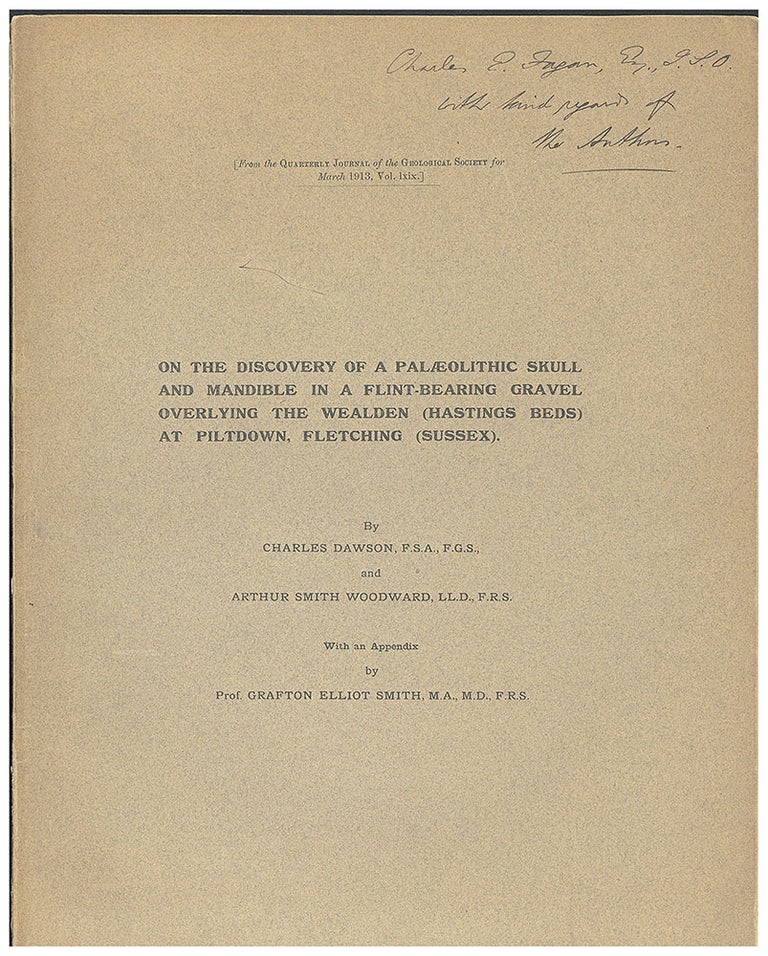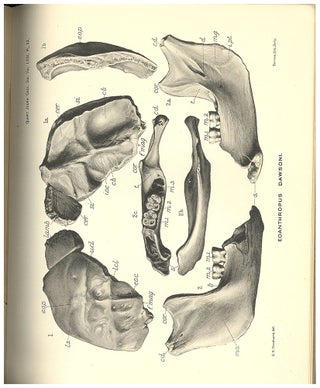On the discovery of a palaeolithic skull and mandible in a flint-bearing gravel ... Offprint. Presentation copy.
Publisher Information: 1913.
Dawson, Charles (1864 — 1916) & Arthur Smith Woodward (1864 — 1944). On the discovery of a palaeolithic skull and mandible in a flint-bearing gravel overlying the Wealden (Hastings Beds) at Piltdown, Fletching (Sussex) . . . With an appendix by Prof. Grafton Elliot Smith, M.A., M.D., F.R.S. Offprint from Quarterly Journal of the Geological Society 69 (March, 1913). 117-151pp. 7 plates. 299 x 131 mm. Original printed wrappers, small splits at spine. Very good. Boxed.
Presentation Copy, inscribed on the front wrapper by Woodward, "With the complements of the Authors."
First Edition, Offprint Issue, of the official announcement of the discovery of “Piltdown Man,” the most daring and egregious archeological hoax ever perpetrated on the scientific community. The offprint was printed on “large paper” so that the 7 plates illustrating the paper did not need to be folded in half like required in the standard journal publication. Only three copies of this offprint have appeared on the market during the past 50 years.
Sometime between 1908 and 1911 Charles Dawson, a British solicitor and amateur antiquarian / paleontologist, came upon some fragments of a fossilized human skull in a gravel pit outside of Barkham Manor in Piltdown, a small village in the English county of Sussex. In February 1912 Dawson sent a letter announcing this find to Arthur Smith Woodward, Keeper of Geology at the Natural History Museum in London. The following June Woodward and Dawson, accompanied by French paleontologist Pierre Teilhard de Chardin, conducted their first excavations in the gravel pit. During these excavations the three men discovered more skull fragments together with an apelike lower jawbone and some worked flints.
In November 1912 news of the Piltdown discovery was leaked to the popular press. The Manchester Guardian ran a story on November 21 describing the Piltdown remains as “by far the earliest trace of mankind that has yet been found in England” and hinting that the remains might represent the “missing link” between anthropoid apes and humans. In December Woodward, Dawson and anatomist Grafton Elliot Smith made their formal presentation of the Piltdown discovery at a meeting of the Geological Society, arguing that that the Piltdown remains belonged to a single individual hominid from the early Pleistocene, which they christened Eoanthropus dawsoni.
“Piltdown Man” was accepted as genuine by a number of prominent scientists, in large part because the remains conformed to the then-current theory that the large brain case in modern humans had evolved prior to the modern human jaw. Another factor leading toward its acceptance was the well-documented history of finding eoliths in the Sussex region where the Piltdown remains were “discovered.” Eoliths were then considered the earliest tools made by precursors of man by adherents to the eolith theory. Eventually eoliths were recognized as having been formed by natural causes—as geofacts rather than artifacts. Finally, certain establishment scientists in England welcomed the possibility presented by the Piltdown remains that prehistoric man had evolved in England rather than in Africa or Asia.
After acceptance by a wide percentage of the paleoanthropological community through the 1940s, Piltdown gradually fell into disfavor when discoveries such as Peking Man and South Africa’s Taung Child showed that the opposite was true: The human jaw had in fact appeared first. As the twentieth century progressed Piltdown Man became increasingly marginalized as an inexplicable anomaly, until it was finally exposed as a hoax through precise scientific dating of the Piltdown remains in the early 1950s. Since the fraud was proven, a rather exhaustive literature has developed concerning competing theories as to the perpetrator or perpetrators of this hoax. One of the most convincing is that Dawson was responsible, since he is known to have perpetrated other hoaxes. However, the identity of the perpetrator or perpetrators may never be conclusively known.
. Garrison-Morton.com 211. Spencer, Ecce homo, no. 4.629.
Book Id: 50344Price: $7,500.00



